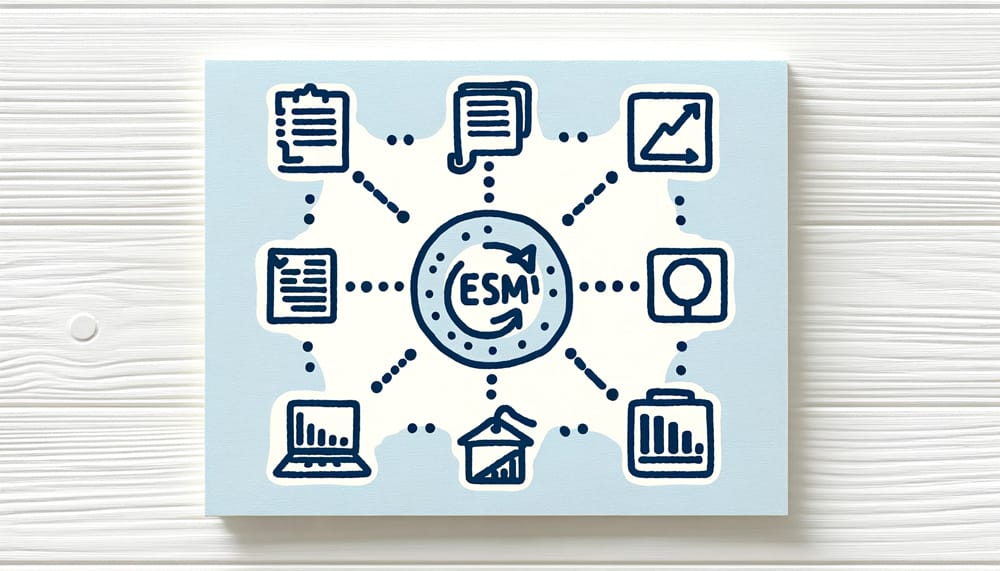Introduction to ESM Prompts
The Central Role of Prompts in Experience Sampling Method
In the realm of Experience Sampling Method (ESM) research, prompts act as the catalysts for data collection, bridging the gap between everyday experiences and valuable insights. These prompts are designed to trigger participants’ responses at specific moments, capturing the essence of their thoughts, feelings, and behaviors in real-time. The efficacy of an ESM study largely hinges on the effectiveness of these prompts, making them a central component of the research design. For further insights into the foundational aspects of ESM, Introduction to Experience Sampling Method (ESM) provides a comprehensive overview.
“Prompts in ESM are like keys that unlock the doors to participants’ inner worlds, revealing the unseen and unspoken aspects of their daily lives.”
For more insights into the impact of prompt frequency in ESM and strategies to optimize it, Improving Compliance in ESM Data Collection offers valuable information and practical approaches.
The Importance of Crafting Effective Prompts
Creating effective ESM prompts is both an art and a science. It involves more than just asking questions; it’s about framing them in a way that resonates with participants, encourages engagement, and elicits accurate and meaningful responses. The importance of crafting effective prompts lies in several key areas:
-
- Enhancing Data Quality: Well-designed prompts lead to higher quality data, as they help participants provide more precise and reflective responses.
-
- Increasing Participant Engagement: Engaging and thoughtfully constructed prompts can significantly boost participant interest and involvement, reducing the likelihood of response fatigue.
-
- Ensuring Relevance and Contextuality: Effective prompts are tailored to the study’s objectives and sensitive to the participants’ context, ensuring that the data collected is relevant and insightful.
Crafting effective ESM prompts requires a deep understanding of the study’s goals, the target population, and the nuances of human psychology. It’s a critical step that, when done correctly, can profoundly impact the study’s success.
In conclusion, the design of ESM prompts is a crucial aspect of any ESM study. Effective prompts are the linchpin in capturing high-quality, contextual data and are fundamental to achieving the study’s research objectives. As we delve deeper into the intricacies of crafting these prompts, the following sections will provide practical tips and examples to guide researchers in this vital process.
Basics of Prompt Design

Key Principles in Prompt Design
In crafting prompts for Experience Sampling Method (ESM) studies, there are several fundamental principles that researchers should adhere to. These principles are designed to maximize response quality and participant engagement, thereby enhancing the overall effectiveness of the study.
- Clarity and Simplicity: Prompts should be straightforward and easy to understand. Avoid complex wording or technical jargon that might confuse participants.
- Relevance and Specificity: Ensure that each prompt is directly related to the study’s objectives. The prompts should be specific enough to elicit detailed responses, but not so narrow as to limit the participant’s ability to provide a comprehensive answer.
- Consistency: Maintain consistency in the structure and tone of the prompts throughout the study. This helps in reducing confusion and allows for better comparison of responses over time.
- Context Sensitivity: Design prompts that are sensitive to the participant’s context. This means considering the time, location, and the potential situation of the participant when they receive the prompt.
- Cultural Appropriateness: Be aware of cultural nuances and language differences that might affect how prompts are interpreted by participants from diverse backgrounds.
“Effective prompt design is the art of asking the right question, in the right way, at the right time.”
For further insights into designing effective ESM prompts and enhancing participant engagement, resources like Participant Engagement in ESM Studies can be invaluable.
Balancing Clarity and Engagement
Creating ESM prompts that are both clear and engaging can be challenging, but it’s crucial for the success of the study. Here’s how to strike this balance:
-
- Use Open-Ended Questions: While clarity is important, incorporating open-ended questions can encourage participants to provide more detailed and nuanced responses.
-
- Incorporate Variety: Mix different types of prompts (e.g., scale-based, yes/no, open-ended) to keep participants engaged and to gather diverse types of data.
-
- Personalization: Whenever possible, personalize prompts to make them more relatable and engaging for participants. This could involve using the participant’s name or tailoring questions based on previous responses.
-
- Test and Iterate: Pilot test your prompts with a small group and gather feedback. Use this feedback to refine and improve the prompts for clarity and engagement.
For more detailed guidance on effective ESM prompt design, including balancing clarity with engagement, resources such as Designing an ESM Study: Key Considerations and Steps can be extremely helpful.
In summary, the basics of prompt design in ESM involve crafting questions that are clear, relevant, consistent, context-sensitive, and culturally appropriate. Balancing these elements with the need to keep participants engaged is key to eliciting rich, meaningful data that can provide valuable insights into the research questions at hand.
Writing Clear and Concise Prompts

Techniques for Creating Clear Prompts
In Experience Sampling Method (ESM) research, the clarity of prompts is crucial for obtaining accurate and relevant responses. Here are techniques to ensure your prompts are clear:
- Use Simple Language: Avoid complex vocabulary or technical jargon. The prompt should be easily understandable to someone outside your field of expertise.
- Be Direct and Specific: Each prompt should focus on a single idea or question. Avoid multi-faceted questions that can lead to confusion or mixed responses.
- Avoid Leading Questions: Ensure that the prompts are neutral and do not lead participants toward a particular answer.
- Use Familiar Terms: Employ terminology that is familiar to the participant pool. If using any specialized terms, provide clear definitions.
- Consistent Format: Maintain a consistent format across prompts. This helps participants quickly understand what is being asked each time.
“Clarity in ESM prompts is like shining a light on a path, guiding participants to provide the precise information needed.”
Examples of Concise Prompts Across Different Research Areas
To illustrate how these techniques can be applied across various research areas, here are some examples of concise prompts:
Mental Health Research:
-
- Prompt: “On a scale of 1 to 5, how would you rate your mood right now?”
-
- Explanation: This prompt is clear, uses simple language, and asks for a specific piece of information.
Workplace Studies:
-
- Prompt: “Describe in a few words how you are feeling about your work today.”
-
- Explanation: Direct and to the point, this prompt invites an open-ended response but is focused on a specific aspect – the participant’s current feelings about work.
Educational Research:
-
- Prompt: “How focused do you feel right now in your learning activity? (Not focused at all – Extremely focused).”
-
- Explanation: This prompt is structured with a clear scale, making it easy for participants to respond accurately.
In summary, writing clear and concise prompts involves using simple, direct language, being specific, and avoiding leading questions. The prompts should be tailored to the research area and participant demographic, ensuring they are relevant and easily understood. By adhering to these principles, researchers can significantly enhance the quality of the data collected in ESM studies, leading to more reliable and insightful findings.
Engaging Participants with Prompts

Strategies to Make Prompts Engaging
In Experience Sampling Method (ESM) studies, engaging participants through well-crafted prompts is crucial for maintaining interest and ensuring high-quality responses. Here are effective strategies to enhance prompt engagement:
- Personalization: Tailor prompts to the participant’s experiences or characteristics. Using the participant’s name or referencing their previous responses can make prompts feel more personal and relevant.
- Variety in Question Types: Mix up the types of questions – from multiple-choice to scales and open-ended questions. This variety can keep participants more engaged and provide richer data.
- Interactive Elements: Where possible, use interactive elements in digital prompts, such as sliders for scales or clickable options. This can make the process more dynamic and interesting.
- Contextual Relevance: Ensure that prompts are relevant to the participant’s current situation or recent experiences. This relevance can make the prompts more engaging and the responses more meaningful.
- Encourage Reflection: Design prompts that encourage participants to reflect on their experiences or feelings. Reflective questions can lead to more thoughtful and detailed responses.
“Engaging prompts are like a friendly conversation; they invite participants to share their experiences in a way that feels natural and meaningful.”
Incorporating Participant-Centric Elements
To further enhance engagement, incorporating elements centered around the participant’s perspective and experience is key:
-
- Use Familiar Language: Employ language and terms that resonate with your participant group. If your participants are teenagers, for example, use phrases and references that are relevant to their age group.
-
- Timely and Relevant: Time the prompts so they appear at moments when participants are most likely to provide rich information. For instance, sending a prompt about workplace stress during work hours.
-
- Feedback Opportunities: Allow participants to give feedback on the prompting process itself. This can make them feel more involved and valued in the study.
-
- Respect Participant Burden: Keep prompts concise and mindful of the participant’s time and effort. Long or frequent prompts can lead to fatigue and disengagement.
For more strategies on participant engagement in ESM, resources like Improving Compliance in ESM Data Collection offer valuable insights.
In conclusion, making prompts engaging in ESM involves personalization, variety, interactivity, and participant-centric elements. By focusing on these aspects, researchers can create a prompting experience that not only maintains participant interest and involvement but also enhances the quality and depth of the data collected. Engaged participants are more likely to provide insightful and accurate responses, thereby enriching the overall outcomes of the study.
Tailoring Prompts to Research Goals

Aligning Prompts with Specific Research Objectives
In Experience Sampling Method (ESM) studies, the effectiveness of the prompts is significantly amplified when they are closely aligned with the specific objectives of the research. Tailoring prompts to fit the study’s goals ensures that the data collected is directly relevant and valuable in addressing the research questions. Here’s how to align prompts with research objectives:
- Reflect on Study Aims: Start by clearly understanding your study’s aims. What are the key questions you seek to answer? What specific aspects of participants’ experiences or behaviors are you looking to explore?
- Design Prompts for Specific Insights: Each prompt should be crafted to elicit information that contributes directly to your research goals. If your study aims to explore emotional well-being, for instance, prompts should be designed to reflect upon emotional states.
- Ensure Relevance and Specificity: The prompts should be relevant to the participants’ experiences and specific enough to elicit detailed responses that align with your research objectives.
- Adapt to Evolving Goals: Be open to adapting your prompts if the research objectives evolve or if initial data collection suggests a shift in focus.
“Tailored prompts in ESM are like precise instruments in a scientist’s toolkit, each uniquely designed to measure a specific aspect of the research puzzle.”
Examples of Tailored Prompts for Various Study Aims
To illustrate, here are examples of how prompts can be tailored to different research goals:
Study on Work-Related Stress:
-
- Prompt: “How would you rate your current level of stress at work on a scale from 1 (very low) to 5 (very high)?”
-
- Explanation: This prompt directly addresses the research goal of measuring work-related stress levels.
Study on Dietary Habits:
-
- Prompt: “What did you eat for your last meal? Please include approximate quantities.”
-
- Explanation: This prompt is tailored to gather specific information about dietary habits, aligning with the study’s aim of exploring eating patterns.
Study on Physical Activity and Health:
-
- Prompt: “Have you engaged in any physical activity today? Please describe the type and duration.”
-
- Explanation: This prompt is designed to collect data on physical activity, relevant to the study’s focus on health and exercise.
In conclusion, tailoring prompts to align with research goals is a critical step in ESM studies. By ensuring that each prompt is purposefully crafted to gather data directly relevant to the study’s objectives, researchers can significantly enhance the effectiveness of their data collection and the overall impact of their research.
Cultural and Contextual Considerations

Adapting Prompts for Diverse Cultural and Contextual Settings
In Experience Sampling Method (ESM) research, acknowledging and adapting to cultural and contextual differences is crucial for the accuracy and relevance of data collected. Diverse cultural backgrounds and contexts can significantly influence how participants interpret and respond to prompts. Here’s how to adapt prompts for diverse settings:
- Cultural Sensitivity: Be aware of cultural norms, values, and language nuances. Prompts should be framed in a way that is culturally appropriate and sensitive to avoid misinterpretation or offense.
- Contextual Relevance: Ensure that the prompts are relevant to the participants’ everyday lives. This may involve considering factors like the participants’ geographical location, socioeconomic status, or occupation.
- Language and Translation: When conducting studies in multilingual settings, it’s vital to ensure accurate translation of prompts. Consider the subtleties and idiomatic expressions of each language.
- Consultation with Cultural Experts: Engage with cultural experts or local researchers who can provide insights into the appropriateness and effectiveness of prompts in specific cultural contexts.
“Effective ESM prompts are not just about asking questions; they are about asking the right questions in a way that resonates across different cultural and contextual tapestries.”
Testing and Refining Prompts

Importance of Pilot Testing Prompts
Pilot testing is an indispensable step in the Experience Sampling Method (ESM) process, especially when it comes to refining prompts. This preliminary phase serves several critical purposes:
- Assessing Clarity and Relevance: Pilot testing helps determine whether the prompts are clearly understood by participants and whether they effectively capture the intended data.
- Identifying Potential Misinterpretations: It can reveal if prompts are being misinterpreted, allowing for adjustments to be made before the full study is launched.
- Evaluating Participant Engagement: This stage provides an early indication of how engaging the prompts are for participants, which is crucial for maintaining high response rates.
- Testing Technical Aspects: Especially in digital ESM platforms, pilot testing ensures that prompts are delivered and recorded correctly.
“Pilot testing in ESM is like the dress rehearsal before the main performance, ensuring each prompt plays its part flawlessly.”
Methods for Refining Prompts Based on Feedback
Once pilot testing is completed, refining the prompts based on the feedback and data gathered is essential. Here are methods to effectively refine ESM prompts:
- Analyze Participant Feedback: Collect and carefully analyze feedback from pilot participants regarding the prompts’ clarity, relevance, and engagement level.
- Modify for Clarity and Context: Revise prompts that are consistently misunderstood or misinterpreted, ensuring they are clear and contextually appropriate.
- Adjust Language and Tone: Based on participant feedback, adjust the language and tone of the prompts to better align with the target demographic.
- Refine Technical Delivery: If using digital tools, make technical adjustments to the timing, frequency, or presentation of the prompts as needed.
- Iterative Process: Refining prompts is an iterative process. It might require multiple rounds of pilot testing and refinement to get it right.
For more detailed methodologies on pilot testing and refining ESM prompts, resources like Analyzing ESM Data: A Step-by-Step Guide can provide comprehensive strategies and examples.
In conclusion, pilot testing and refining prompts are crucial steps in the ESM study process. They ensure that the prompts are effectively designed to elicit meaningful, accurate, and reliable responses, thereby strengthening the overall quality and validity of the research.
Conclusion and Best Practices
Key Takeaways for Crafting Effective ESM Prompts
Crafting effective prompts in Experience Sampling Method (ESM) research is a critical skill that can significantly impact the quality of data collected. Key takeaways include:
-
- Clarity and Simplicity: Ensure that prompts are clear, concise, and easily understandable, avoiding ambiguity and complexity.
-
- Cultural and Contextual Relevance: Tailor prompts to fit the cultural and contextual backgrounds of participants to ensure accurate interpretation and meaningful responses.
-
- Engagement and Personalization: Design prompts that are engaging and, where possible, personalized to maintain participant interest and motivation.
-
- Alignment with Research Goals: Carefully align prompts with the specific objectives of your study to ensure that they elicit relevant and useful data.
-
- Pilot Testing and Refinement: Utilize pilot testing to refine prompts based on participant feedback, ensuring their effectiveness before full-scale deployment.
“In the world of ESM, a well-crafted prompt is the golden key to unlocking rich, insightful data that lies at the heart of human experience.”
Final Tips and Best Practices for Prompt Creation
To ensure the creation of effective ESM prompts, remember these final tips:
-
- Keep it Short and Sweet: Aim for brevity to minimize participant burden and maintain focus.
-
- Test for Comprehension: Pilot test prompts with a diverse sample to ensure they are universally understood.
-
- Iterate and Evolve: Be prepared to revise and adapt prompts based on ongoing feedback and findings.
-
- Balance Variety and Consistency: Use various types of questions to keep engagement high, but maintain a consistent structure for ease of response.
You Might Also Be Interested:
Delve into our comprehensive ESM Article Collection for insightful perspectives on Experience Sampling Method (ESM).
See our article Best Tools for Experience Sampling Method in 2024 to discover the top tools in the field.
Learn how the advanced features of Fibion Insight can aid your ESM research.
Planning an ESM study? For a chat with our ESM expert, book a video call with Dr. Miriam Cabrita.
Frequently Asked Questions in this topic
What is the Importance of Crafting Effective ESM Prompts?
Effective ESM prompts are crucial for eliciting meaningful and accurate responses in Experience Sampling Method research. They enhance data quality, increase participant engagement, and ensure relevance and contextuality.
What are Key Principles in ESM Prompt Design?
Key principles include clarity and simplicity, relevance and specificity, consistency, context sensitivity, and cultural appropriateness.
How Can Prompts be Made Clear and Concise?
Prompts should use simple language, be direct and specific, avoid leading questions, use familiar terms, and have a consistent format.
What Strategies Enhance Engagement in ESM Prompts?
Strategies include personalization, variety in question types, interactive elements, contextual relevance, and encouraging reflection.
How Should Prompts be Tailored to Research Goals?
Prompts should be aligned with the study’s aims, designed for specific insights, and adaptable to evolving goals. They should be relevant and specific to elicit detailed responses.
Why are Cultural and Contextual Considerations Important in Prompt Design?
Adapting prompts for different cultures and contexts ensures accuracy and relevance of data, avoiding misinterpretation and enhancing the validity of responses.
What is the Role of Pilot Testing in Refining Prompts?
Pilot testing helps assess clarity, relevance, participant engagement, and technical aspects of prompts, allowing for refinement and improvement.










 Delve into our comprehensive
Delve into our comprehensive  See our article
See our article  Learn how the advanced features of
Learn how the advanced features of  Planning an ESM study? For a chat with our ESM expert,
Planning an ESM study? For a chat with our ESM expert, 




